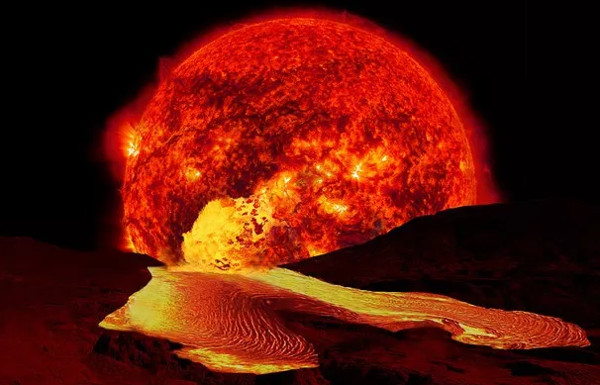The terrible secret of giant red stars
After 90 years of research, scientists have discovered this mystery.
What's inside the giant red star?
Previously, we knew red giants were a giant star at the end of the evolutionary journey. They have a diameter more than a hundred times our Sun. And because the supply of hydrogen in the core is depleted, the red giants turn to hydrogen synthesis in the outer shell. What's inside of these stars? This mystery has just recently been revealed.
A group of astronomers from many different countries have for the first time explained what is going on inside a red giant star. After looking deeply into the surface of dozens of red giants, they discovered there were hidden objects that caused extremely strong magnetic fields.

What's inside a red giant star?
Of course, no probe could enter a star. The technique that scientists use is called 'asteroseismology' , roughly translating as 'seismic star' . Specifically, they will exploit the wave data on their surface to explain what is happening in the deeper layer. It is easy to understand this is like performing medical ultrasound techniques.
However, the two types of waves that scientists care about are the pressure waves from the star's internal instability. This wave is like a normal sound wave. The second type that can be used is gravity waves driven by the floating of different layers of the star. All the data extracted from these two types of waves is used to recreate what is inside a red giant.
GRB red giant stars have been selected as the main research subjects. They are all at the end of evolution. Because the synthesis of hydrogen outside the crust by the fusion reaction makes them "swell" quickly. They have a thin and inflated atmosphere, a dense helium core and a hundred times the radius of the original star.
Because of this, they make them excellent candidates for 'asteroseismology' technology . Its pressure waves do not escape the core, but they convert into gravitational waves. These waves pass through each layer in the star's heart and cause vibrations according to different models. One of the relatively special models makes one side of the star brighter, in which the other side fades away, called the dark light dipole.
The team found that a strong magnetic field inside the star causes gravity waves to be trapped. They call it 'the magnetic greenhouse effect' . And this makes the star's bipolar dark light less clear.

Correlate the size of the red giant with the Sun.
Noting this, NASA used the Kepler telescope to observe the dark bipolar reduction of some red giants. Combined with data from the research team, they calculated that the 'magnetic greenhouse effect' is confined inside a red giant star a magnetic field that is more than 10 million times stronger than the Earth's magnetic field. Dr. Jim Fuller, the team leader said: 'This is the first time we can detect and measure the magnetic field inside a star. This discovery will help us better understand a star's life cycle. '
The magnetic field detection in the core of a red giant is a remarkable study. Dr. Matteo Cantiello, co-author of the study, said: 'In 1926, the famous astronomer Sir Arthur Eddington lamented that a star's core is the most inaccessible thing in the universe. Nearly 90 years have passed and we have done this. If Eddington is here today, perhaps he will be surprised and excited. '
- Discovering a star 300 times larger than the sun
- Detects 5 oversized stars on galaxies
- Couples cause trouble in the universe
- The star explodes near Earth, destroying giant sharks
- The mysterious death of some stars
- The mystery of giant stars: Do they explode?
- 9 interesting things about stars
- Giant stars are created from 'star nursery'.
- The explosion of cosmic light was struck by two young stars
- The giant area proliferates new stars
- The new discovery of a star is said to be a giant structure of aliens
- Explain the mystery of missing stars in the universe
 Van Allen's belt and evidence that the Apollo 11 mission to the Moon was myth
Van Allen's belt and evidence that the Apollo 11 mission to the Moon was myth The levels of civilization in the universe (Kardashev scale)
The levels of civilization in the universe (Kardashev scale) Today Mars, the sun and the Earth are aligned
Today Mars, the sun and the Earth are aligned The Amazon owner announced a secret plan to build a space base for thousands of people
The Amazon owner announced a secret plan to build a space base for thousands of people A shooting star, about to explode in the sky of Earth?
A shooting star, about to explode in the sky of Earth?  Image of a new star spewing gas loudly across the Milky Way galaxy
Image of a new star spewing gas loudly across the Milky Way galaxy  The 'deadly' truth about strange radio signals transmitted to Earth
The 'deadly' truth about strange radio signals transmitted to Earth  Scientists Stunned to Discover Star With Supersonic Tsunamis Three Times Higher Than the Sun
Scientists Stunned to Discover Star With Supersonic Tsunamis Three Times Higher Than the Sun  Death 11.5 Billion Years Ago Bombs NASA: A Chilling Prediction for Us
Death 11.5 Billion Years Ago Bombs NASA: A Chilling Prediction for Us  In 2024, the cosmic monster in the 13th century ancient text will return.
In 2024, the cosmic monster in the 13th century ancient text will return. 